The Bureau of Labor Statistics (BLS) drilled down into the details of how American workers work to produce its first-ever Occupational Requirements Survey, the results of which were released recently. The establishment-based survey and provides information about the physical demands, mental requirements, education and training, and environmental conditions of jobs in the U.S. economy.
Among its findings:
Physical demands
- Workers spent 61.0 percent of the workday standing or walking.
- The average maximum weight lifted or carried as required in all civilian (private industry and state and local government) jobs was about 36 pounds.
- Thirty-seven percent of jobs allowed workers the flexibility to choose alternating between sitting and standing or walking. Overhead reaching was required for 65.9 percent of jobs, while climbing ramps or stairs was required for 29.0 percent of jobs.
- Time spent on the job performing physical activities is published in hours and as a percentage of the day. The latter is standardized to account for the work schedule. Workers, on average, spent about 3 hours (or 39.0 percent of the workday) sitting and spent almost four and a half hours (or 61.0 percent of the workday) standing or walking per workday.
- Workers in construction and extraction jobs stood or walked an average of nearly 7 hours per workday.
- The average maximum weight lifted or carried required by construction and extraction jobs was about 66 pounds.
- Nearly a quarter (24.6 percent) of food preparation and serving related jobs required climbing ramps or structure-related stairs.
Hazards
- Forty-seven percent of jobs required outdoor work.
- About 20.3 percent of jobs exposed workers to moving mechanical parts throughout the workday.
- Personal protective equipment was used by 10.7 percent of workers to mitigate the risk of serious workplace injuries or illnesses associated with moving mechanical parts.
- Most installation, maintenance, and repair jobs (69.5 percent) exposed workers to moving mechanical parts. For 35.7 percent of workers, personal protective equipment was used to mitigate risks associated with this exposure.
- Almost all (96.4 percent) industrial machinery mechanics are exposed to moving mechanical parts and 55.1 percent of workers used personal protective equipment.
Environmental requirements:
- More than 3 in 4 (77.0 percent) building and grounds maintenance jobs required working outdoors at some point during the workday.
- All landscaping and groundskeeping jobs required working outdoors at some point during the workday, and 88.3 percent of jobs required working outdoors constantly. Constantly is defined as 67 percent or more of the workday.
Interacting with others
- Ongoing interaction with regular contacts (people with whom a worker has an established working relationship) was required for 33.7 percent of jobs, and an additional 39.1 percent required interacting with regular contacts several times an hour. For other contacts (the public and those with whom the worker has no working relationship) 17.2 percent of jobs required ongoing interaction and 17.6 percent required interacting with other contacts several times per hour.
- Ongoing interaction with regular contacts was required for 71.8 percent of education, training, and library jobs. Interaction several times per hour with regular contacts was required for 16.6 percent of these same jobs.
- Among office and administrative support occupations 20.8 percent required ongoing interaction with other contacts, and 24.6 percent required interaction several times per hour.
- The majority of customer service representatives required ongoing interaction with other contacts, 53.1 percent, and 23.4 percent required interaction several times per hour with other contacts.
Education, experience and training
- A minimum level of education was not required for 30.6 percent of jobs, although 74.7 percent of all jobs required on-the-job training. Prior work experience was required for 47.8 percent of all civilian jobs. Pre-employment training can often result in a certification or license, and 21.8 percent of jobs required workers to obtain a professional certification, license, or undertake other pre-employment training.
- A bachelor’s degree was required for 59.6 percent of management jobs and 68.6 percent of treasurers and controllers jobs.
- For architecture and engineering jobs, 78.5 percent required prior work experience with an average length of just over 4.5 years (about 1,700 days).
- The majority (57.1 percent) of transportation and material moving jobs do not have a minimum education requirement.
- Most (60.3 percent) bus driver jobs required a high school diploma.
- The ORS also captures and publishes information on the preparation time needed for a typical worker to attain the necessary education, experience, and training to successfully perform a job: Approximately 29.6 percent of jobs had a preparation time requirement that included more than a short demonstration to 1 month of training and 15.7 percent of jobs required 4 to 10 years of preparation time.






